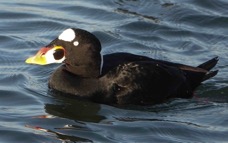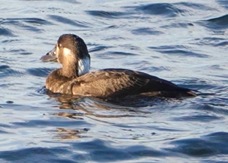Surf Scoter

ComingsBirds.com
to the beauty of birds

- Home California Birds
- SLIDESHOW
- SUMMARY OF ALL BIRDS
- MOVIES
- American Avocet
- American Coot
- Blackbirds/Crows
- Blue-grey gnatcatcher
- Brant
- Brown Pelican
- Chickade Mountain
- Comings' Backyard
- Common Loon
- Curlew Long-billed
- Dowitcher Long-billed
- Dowitcher Short-billed
- DUCKS
- EGRETS
- Dunlin
- Godwit Marbled
- Goldfinch Lesser
- GREBES
- Gnatcatcher Blue-grey
- Grosbeak Black-headed
- Gull California
- HUMMINGBIRDS
- Gull Heermann's
- Heron Black-crowned
- Heron Great Blue
- House Finch
- Jays
- Killdeer
- Merganser Red-breasted
- Nutcracker Clark's
- NutmegMannikin.com
- Other Birds
- Phainopepla
- Phoebe Say's
- Plover Black-bellied
- Plover Western Snowy
- Quail California
- Kittywake Black-legged
- Recent Additions
- Roadrunner Greater
- Sandpiper Least
- Sandpiper Western
- Sally's Fish
- Sanderling
- Shore Birds Other
- Skimmer Black
- Sparrow White-crowned
- Song Sparrow
- Stilt Black-necked
- Surf Scoter
- Swallow Tree
- Teal Blue-winged
- Teal Green-Winged
- Teal Cinnamon
- Tern Common
- Tern Elegant
- Turnstone Black
- Turnstone Ruddy
- Western Meadowlark
- Whimbrel
- Willet
- Yellow Leggs
- WOODPECKERS
- Template
- Contact Me
The Surf Scoter (Melanitta perspicillata) is a large sea duck native to North America. Adult males are entirely black with characteristic white patches on the forehead and the nape and adult females are slightly smaller and browner. Surf scoters breed in Northern Canada and Alaska and winter along the Pacific and Atlantic coasts of North America. Those diving ducks mainly feed on benthic invertebrates, mussels representing an important part of their diet.
Like many other bird species, the surf scoter was first described by Carl Linnaeus in the 1758 10th edition of Systema Naturae. He gave it the binomial name Anas perspicillata. The genus name Anas is the Latin name for ducks. The specific name is from the Latin perspicillatus, "spectacled", in turn derived from perspicere, "to see through”.
The surf scoter was then moved in the Melanitta genus. The name of this genus is derived from Ancient Greek melas "black" and netta "duck" and it contains 5 extant scoter species.
The genus Melanitta is part of the Mergini tribe, a monophyletic group of the Northern Hemisphere. It includes eiders, mergansers, goldeneyes and other sea ducks. This tribe is part of the family Anatidae, along with the swans and geese.
The male is completely velvety black except for white patches on the forehead and the nape. It has a swollen bill, appearing orange at a distance but patterned with white, red and yellow, and a black spot near the base. The female is browner than the male, with a fairly uniform plumage, slightly darker above than below. Indistinct paler patches are present on the cheeks below the eye and sometimes a whitish patch is on the nape, a unique trait among scoters.
The surf scoter is easily distinguishable from other scoters by the white patch on the head of the adult male and its unique bill pattern. Females and immatures have a bulkier bill and a more flattened head profile than other scoters, recalling the shape of the common eider (Somateria mollissima). The black and the white-winged scoters are physically very similar to the surf scoter but in flight, the surf scoter is the only one with completely dark wings.
Surf scoters form pairs on wintering and staging grounds. Most pairs are formed before the arrival on the breeding grounds. Studies showed a strong fidelity in the nesting areas of surf scoters over the years.
The surf scoter mainly feeds on benthic invertebrates. During the breeding period, surf scoters forage in pairs or small groups on a diverse range of freshwater invertebrates. However, the sea ducks feed on marine organisms for the rest of the year, in flocks ranging from a few individuals to several thousands birds. Important foods include crustaceans, herring spawn, gastropods and small bivalves such as mussels.
Flocks of surf scoter appear to dive in a highly synchronous fashion and this synchrony is correlated with the group size. Dive duration vary with many factors such as prey type, density and profitability, season and water depth.
Surf scoters are generally silent and their few vocalizations are poorly known. During courtship display, males perform a gurgling call and an explosive puk-puk. Females defend their young with a crowlike call.
Scientists said that while the species is not endangered it has declined 50 to 70% over the past 40 years and this spill could decrease populations since most of the affected birds are healthy adults.
The extremely large range and population size of the surf scoter assures it a status of Least Concerned, according to the IUCN. The populations have been apparently decreasing over the last years, but this small decline is not rapid enough to consider moving the species in the Vulnerable category. The global population is estimated to be between 250,000 and 1,300,000 individuals.
Wikipedia
© 2009 David Comings Contact Me












